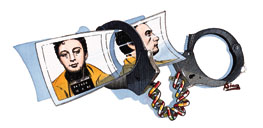Main Menu · Search ·Current Issue ·Contact ·Archives ·Centennial ·Letters to the Editor ·FAQs

Sleuthing the Genes |
In 1991, a Lake County, Florida, man was out on a healthy morning jog when he made a grisly discovery: a woman's body. When he reported the incident to the police, the jogger was dismayed to become the prime suspect in the murder/rape case. Luckily for him, investigators recovered semen from the corpse, from which they extracted DNA. When the Florida Division of Law Enforcement compared certain identifying characteristics, or alleles, in the jogger's DNA with those found in the semen, there was no match. The jogger was cleared, and the police logged the DNA profile into their databank, where it could be compared with the computerized DNA profiles of thousands of prior and subsequent offenders. Four years later, a match, or "hit," popped out, leading police to a man who had previously been convicted of sexual assault.
But the case hit a snag when the defendant's lawyer challenged the admissibility of the DNA evidence. That's when the prosecutor called on Frederick Bieber, associate professor of pathology at Harvard Medical School. Bieber, a medical geneticist at Brigham and Women's Hospital, is an expert on forensic DNA analysis. He testified that the DNA pattern found at the crime scene and in the defendant's DNA were identical. The chance of finding another, unrelated person with the same configuration of alleles was about one in a million. The judge admitted the genetic evidence, and the defendant was convicted.
"Keep in mind that you can exonerate or exclude suspects on the basis of DNA testing," Bieber says. "It's no small footnote that one-third of suspects whose DNA is typed are excluded, so the technology has great exculpatory power that is often lost in the debate about databanking."
Nowhere is that debate more intense than in Massachusetts, which in 1997 became one of the last states to enact legislation calling for the collection of DNA from certain prisoners, parolees, and probationers. Shortly thereafter, the American Civil Liberties Union of Massachusetts and the state public-defenders' office sued on behalf of seven individuals who felt the DNA download amounted to an unlawful form of "suspicionless search" and seizure that violated their Fourth Amendment rights. Since then, the Massachusetts criminal DNA databank's assets have been frozen.
From immigration status to paternity testing to inheritance disputes, forensic DNA analysis plays an ever-increasing role in legal matters. DNA profiling identified victims of the Oklahoma City bombing and the TWA Flight 800 crash. Nowadays, police seldom note a suspect's blood type; DNA profiles are much more discriminating. Although the evidence-collection and -storage systems of the Los Angeles police department were criticized during the trial of O.J. Simpson, the validity of DNA typing itself was never shaken. Law enforcement has begun to benefit greatly from its precision, wide applicability, and adaptability to computerization.
In some cases, DNA typing reveals a link between previously unrelated crimes, even before suspects have been identified. This offers detectives important clues regarding their quarry's behavior and whereabouts. Forty-nine states are moving to establish databanks that collect and store convicted criminals' DNA profiles; about 35 such databanks are already active.
Bieber thinks it would be "misguided" for Massachusetts to remain the odd state out in criminal DNA databanking. The sample-collection system that he helped design is relatively inexpensive and efficient. Convicts need undergo only a fingerstick to get eight drops of blood that are stored on a chemically treated card that preserves the DNA indefinitely at room temperature. In some other states, prisoners must undergo venipuncture and give a tube of blood, which then must be frozen.
Bieber has occasionally been involved in linking unsolved violent crimes to prisoners who are just days or hours from release from prison. "Depending on the jurisdiction, up to half of all violent felonies are committed by people on probation and parole," he says. "The unfortunate reality of criminal recidivism is a fact, not a hypothesis. We have to protect the privacy of the data, but we also have a duty to protect society from crime, past and future."
~ John F. Lauerman